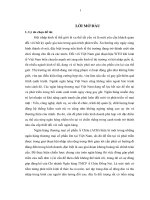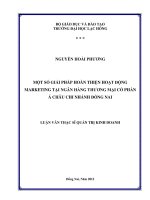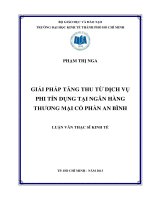(Luận văn thạc sĩ) developing noncredit banking service in techcombank phát triển dịch vụ phi tín dụng tại ngân hàng thương mại cổ phần kỹ thương việt nam
Bạn đang xem bản rút gọn của tài liệu. Xem và tải ngay bản đầy đủ của tài liệu tại đây (1.47 MB, 100 trang )
ĐẠI HỌC QUỐC GIA HÀ NỘI
KHOA QUẢN TRỊ VÀ KINH DOANH
---------------------
LƯƠNG THỊ THU HƯƠNG
DEVELOPING NONCREDIT BANKING SERVICES
AT TECHCOMBANK
PHÁT TRIỂN DỊCH VỤ PHI TÍN DỤNG
TẠI NGÂN HÀNG THƯƠNG MẠI CỔ PHẦN KỸ THƯƠNG
VIỆT NAM
LUẬN VĂN THẠC SĨ QUẢN TRỊ KINH DOANH
HÀ NỘI - 2019
ĐẠI HỌC QUỐC GIA HÀ NỘI
KHOA QUẢN TRỊ VÀ KINH DOANH
---------------------
LƯƠNG THỊ THU HƯƠNG
DEVELOPING NONCREDIT BANKING SERVICES
AT TECHCOMBANK
PHÁT TRIỂN DỊCH VỤ PHI TÍN DỤNG
TẠI NGÂN HÀNG THƯƠNG MẠI CỔ PHẦN KỸ THƯƠNG
VIỆT NAM
Chuyên ngành: Quản trị kinh doanh
Mã số: 60 34 01 02
LUẬN VĂN THẠC SĨ QUẢN TRỊ KINH DOANH
NGƯỜI HƯỚNG DẪN KHOA HỌC: PGS.TS. PHẠM THỊ THANH HÒA
HÀ NỘI - 2019
DECLARATION
I pledge that this thesis is my own research which has been completed
with the support of Assoc. Prof. Dr. Pham Thi Thanh Hoa. The data in the tables
used for analysis and evaluation are true and correct and collected from different
sources with sufficient citations. The solutions stated in the thesis are drawn
from the theoretical bases and the practical research process.
Written by
Luong Thi Thu Huong
i
ACKNOWLEDGEMENTS
I would like to express my sincere gratitude to the lecturers in the 14th
MBA Program of the School of Business and Management, Vietnam National
University, Hanoi (HSB, MBA 14) for dedicatedly teaching and imparting
valuable knowledge to me during my time at the University. Especially, I also
give special thanks to Assoc. Prof. Dr. Pham Thi Thanh Hoa for her thorough
and dedicated guidance during this thesis completion.
In addition, I would like to send my thanks to the Professors, Doctors and
researchers who have made researches in the field of finance – banking, giving
me the information to complete this research.
Despite all efforts, due to limited knowledge and time, the thesis has
inevitably certain shortcomings. I look forward to receiving the comments from
the teachers and friends so that my research may be more perfect.
Yours Sincerely,
Hanoi, November 2018
Author
Luong Thi Thu Huong
ii
TABLE OF CONTENTS
DECLARATION .........................................................................................................i
ACKNOWLEDGEMENTS ....................................................................................... ii
LIST OF ABBREVIATIONS .....................................................................................v
LIST OF TABLES .....................................................................................................vi
LIST OF FIGURES.................................................................................................. vii
INTRODUCTION.......................................................................................................1
CHAPTER 1: BASIC THEORETICAL ISSUES OF DEVELOPING NONCREDIT SERVICES AT COMMERCIAL BANKS .................................................9
1.1. OVERVIEW OF SERVICES OF COMMERCIAL BANKS ..........................9
1.1.1. Concept of banking service .......................................................................9
1.1.2. Characteristics of banking services .........................................................10
1.1.3. Classification of banking services by the nature of revenue sources ......12
1.2. NON-CREDIT SERVICES OF COMMERCIAL BANKS ...........................21
1.2.1. Concept of non-credit services of commercial banks ..............................21
1.2.2. Non-credit service development of commercial banks ...........................21
1.2.3 Risks in non-credit service development of commercial banks ...............38
1.3. EXPERIENCE IN DEVELOPING NON-CREDIT SERVICES AND
LESSONS FOR VIETNAMESE COMMERCIAL BANKS ................................39
1.3.1. Experience in developing non-credit services of banks around the world .......39
1.3.2. Lessons for Vietnamese commercial banks.............................................41
CHAPTER 2: CURRENT STATUS OF THE DEVELOPMENT OF NON-CREDIT
SERVICES AT TECHCOMBANK IN THE 2013-2017 PERIOD ..........................43
2.1 General introduction of Techcombank ............................................................43
2.1.1. Summary of the establishment, development and organizational structure
of Techcombank ................................................................................................43
2.1.2 Business results of Techcombank in the 2013-2017 period .....................49
2.2. Current status of the development of non-credit services at Techcombank in
the 2013 – 2017 period ..........................................................................................53
iii
2.2.1 Analysis of the non-credit service development results at Techcombank in
the 2013 - 2017 period .......................................................................................53
2.2.2 Market share and the number of customers using non-credit services
annually..............................................................................................................63
2.2.3. Customer satisfaction of non-credit services of Techcombank ...............64
2.3 Evaluation of non-credit service development results of Techcombank in the
2013-2017 period...................................................................................................66
2.3.1 Non-credit service development achievements of Techcombank in the
2013-2017 period ...............................................................................................66
2.3.2. Weaknesses and causes of limiting non-credit service development of
Techcombank in the 2013 – 2017 period ..........................................................67
CHAPTER 3: SOME SOLUTIONS TO DEVELOP NON-CREDIT SERVICES AT
TECHCOMBANK ....................................................................................................71
3.1. Non-credit service development strategy of Techcombank by 2017 and vision
to 2020 ...................................................................................................................71
3.2. Solutions to develop non-credit services of Techcombank ............................72
3.2.1. General solutions to develop non-credit services of Techcombank ........72
3.2.2. Particular solution to develop each type of non-credit service at
Techcombank .....................................................................................................76
3.3.2. Recommendations for Vietnam Banks’ Association ...............................82
CONCLUSION .........................................................................................................84
REFERENCES ..........................................................................................................85
APPENDIX ...............................................................................................................88
iv
LIST OF ABBREVIATIONS
No.
Abbreviations
Meaning
1
BHNT
Life insurance
2
CN/PGD
Branch/Transaction office
3
DV
Service
4
DVNH
Banking service
5
DVPTD
Non-credit service
6
KDNT
Foreign currency trading
7
KH
Customer
8
NH
Bank
9
NHDT
E-banking
10
NHTM
Commercial banks
11
TCB
Techcombank
12
TD
Credit
13
TMCP
Joint Stock Commercial
14
TTQT
International Payment
15
VN
Vietnam
v
LIST OF TABLES
Table 2.1 Some basic financial indicators of Techcombank from 2013 to 2017 .....49
Table 2.2 Revenues from non-credit services of Techcombank (2013-2017) ..........53
Table 2.3 List of non-credit products of Techcombank ............................................54
Table 2.4: Revenues from cash and payment services of Techcombank ( 2013 -2017) .........55
Table 2.5: Revenues from insurance commission of Techcombank ( 2013 -2017) .57
Table 2.6: Revenues from Securities issuance guarantee of Techcombank ( 2013 2017)..........................................................................................................................58
Table 2.7 Foreign currency trading at Techcombank ( 2013- 2017) ........................59
Table 2.8: Card revenues of Techcombank in the 2013 – 2017 period ...................61
Table 2.9: The number of ATMs and POSs over the years ......................................61
Table 2.10: Securities service of Techcom Securities in the 2013-2017 period .......62
Table 2.11. Top 5 non-credit services at Techcombank ...........................................64
Table 2.12: Top 3 highest and lowest levels of agreement on facilities, staff and
rationale of products and services. ............................................................................65
vi
LIST OF FIGURES
Figure 2.1: Total assets of Techcombank ( 2013 -2017) ..........................................50
Figure 2.2: Total assets of Techcombank ( 2013 -2017) ..........................................51
Figure 2.3 Market share and the number of customers using non-credit services
annually .....................................................................................................................63
vii
INTRODUCTION
1. Rationale
The international integration process brings about Vietnamese commercial banks
both many opportunities for development and many challenges. Vietnamese
commercial banks are required to strengthen and enhance their competitiveness
through diversification and improvement of financial services.
Inter-industry competition in Vietnam is no less severe. Commercial banks in the
whole country are competing with one another on an hourly basis by launching a
series of new products and services, lowering interest rates, improving processes
and applying modern banking technology. Besides, domestic banks also have to
cope with competition pressure in terms of technology, financial capacity, quality of
services, professionalism in business that are always the strength of foreign banks.
One of the financial restructuring activities of credit institutions in the Restructuring
Plan of Credit Institutions in the 2011-2015 period approved by the Prime Minister
under Decision No. 254/QD- TTg dated March 01, 2012 is “Step by step
transforming the business model of commercial banks in the direction of reducing
dependence on credit activities and increasing revenues from non-credit services”.
Developing non-credit services is the most effective way to change the structure of
a bank’s business performance rather than dependence on risky credit activities and
securities business investment consultancy that is facing many difficulties at
present.
Vietnam Technological and Commercial Joint Stock Bank (Techcombank) was
established on September 27, 1993. Initially, it had only three branches. Now, it
develops rapidly with a network of more than 300 branches nationwide serving
more than 5 million of individual customers, SMEs, large enterprises and FDI
enterprises. By the end of 2017, Techcombank had earnings before tax of 7,500
billion dong, equivalent to 150% of the plan.
At present, Techcombank’s non-credit services are diversified in the following
major forms: payment services, foreign currency business, cards, asset management,
1
treasury, electronic banking, derivatives
transaction, securities brokerage,
Bancassurance, securities underwriting
From the above reality and my awareness from the objective reality, I chose
“Developing non-credit banking services at Techcombank” as a research topic
for my thesis. The thesis will focus on analyzing the following main non-credit
services of Techcombank, including: Payment, card, foreign currency trading,
Bancassurance, Securities underwriting.
2. Literature review
In recent years, the development of non-credit services in Vietnamese commercial
banks have increasingly attracted interest from management levels as well from the
commercial banks themselves and there have been many articles and scientific
works that have been published, which are a valuable source for my thesis. Some of
them are as follows:
“Commercial bank” textbook by Phan Thi Thu Ha, Statistical Publishing House,
Hanoi or Modern Banking Operations by Nguyen Minh Kieu, Statistical Publishing
House, Hanoi. The authors outlined the basic concepts of operation of commercial
banks and clarified their nature, characteristics and types of services. The textbooks
provide a theoretical system for the issue.
According to Dr. Le Xuan Nghia, Director of the State Bank of Vietnam’s
Strategy Department, lending is still the main activity in the Vietnamese banking
system meanwhile the trend of banks around the world is based mainly on service
activities. For a couple of recent years, many domestic banks have strongly reformed,
upgraded and promoted cooperation in services such as cash collection, payment,
syndicated loan, finance capital support for projects, consumer finance, card issuance,
ATM installation, etc.; however, the profit has been still at a modest level.
Pham Anh Thuy (2013) “Developing non-credit services at Vietnamese
commercial banks, Doctoral Dissertation in Economics, Banking University of Ho
Chi Minh City. The disseration provided the theoretical bases of the non-credit
services, analysis of the current status of develloping non-credit services of
commercial banks. The author conducted surveys on non-credit quality and
2
evaluated the current status of developing non-credit services of commercial banks
through quantitative and qualitative methods of quality model of non-credit services
of commercial banks in Vietnam, impact the quality of non-credit services of
Vietnamese commercial banks on the customer satisfaction through cronbach’s
alpha coefficient, EFA analysis and regression analysis. Based on the current status
of developing non-credit services of Vietnamese commercial banks, the thesis
summarized the service development strategy of Vietnamese commercial banks in
2015 and vision to 2020.
In terms of the research into one aspect of non-credit services, through a survey of a
specific bank, Ms. Le Nguyen Anh Dao (2013) researched into “The current status
of developing non-credit services at Vietcombank- Da Nang Branch. In the
theoreotical bases, the author designed the creteria to evaluate the current status of
developing non-credit services at Vietcombank- Da Nang Branch in the 2009-2011
period. Besides, the author also surveyed the quality of non-credit services at
Vietcombank- Da Nang Branch; thereby evaluating and promoting the supply of
non-credit services at Vietcombank- Da Nang Branch. Finally, based on the
development objectives of Vietcombank and the current status, she proposed
solutions and made some recommendations to developing non-credit services in the
coming time.
After reviewing the researches related to the thesis, the author found that previous
studies provided the full foundation of theory of banking services in general and
non-credit services in particular. Besides, the indicators used to evaluate the
development of non-credit services were also found out. The researches provide the
general theories about the factors that affect non-credit services. Some of these
researches built a model for evaluating the development of non-credit services to
improve the efficiency of banks. However, each bank has its own characteristics
subject to the branch and the geographical area of operation and the corporate
culture, so solutions cannot be applied uniformly to all banks.
Therefore, the author wants to study and evaluate the development of non-credit
services of a specific bank- Techcombank. Based on its own characteristics and
3
competitiveness and financial position, the author provides useful solutions for the
researched bank.
The thesis is a comprehensive research into the development of non-credit services
of Techcombank to 2017 based on the analysis of factors related to its
competitiveness and financial condition of banks, thereby finding out appropriate
solutions and giving recommendations to the units in the system. The
recommendations and solutions in the thesis can be applied in the business practice
of banks to maximize the inherent capacity to develop sustainably as well as
consolidate their prestige and competitiveness in the market.
3. Research questions
The research topic is aimed at answering the following specific questions:
1.
What is the development of non-credit services? What are non-credit
services of commercial banks? What is the model for analyzing and measuring the
development and quality of non-credit services at commercial banks?
2.
What is current status of non-credit service development at Techcombank?
3.
Along with the development orientation of Techcombank, what are solutions
to develop non-credit services at Techcombank?
4. Aims and Objectives
Research objectives: Through this thesis, the readers will understand the basic
aspects of non-credit services. Besides, the evaluation of development of non-credit
services at Techcombank in the 2013 - 2017 period will be introduced, thereby
finding out solutions to further develop non-credit services until 2022.
Research aims: To achieve the above reseach objectives, the following tasks should
be carried out:
Firstly, systematize the theoretical issues of banking services, non-financial services
in the system of commercial banks in Vietnam
Secondly, analyze and evaluate the current status of non-credit service development
at Techcombank in the 2013-2017 period, focusing on key services such as payment
and money services, card, foreign exchange trading, life insurance distribution,
bond brokerage.
4
Thirdly, based on the current status and development orientation of the bank along
with the comparison with other commercial banks, propose the solutions to develop
non-credit services at Techcombank in the coming years.
5. Subjects and Scope of study
The research subjects of the thesis is the theory and practice of non-credit service
development at Techcombank; thereby proposing the solutions to develop noncredit services at banks, especially 5 main services such as payment services, cards,
e-banking, life insurance brokerage and bond brokerage.
Research space: non-credit activities at Techcombank
Research time: The thesis focuses on collecting, researching and using data related
to non-credit service development at Techcombank in the 2013-2017 period;
thereby proposing the solutions to develop non-credit services in the coming years
6. Research methods
To evaluate and analyze the development of non-credit services of Techcombank,
the author analyzed the annual reports and conducted a survey on customers using
Techcombank’s non-credit products to see its development in an honest and
objective way. In this thesis, the author also gave financial solutions and
recommendations to further develop Techcombank’s non-credit services in the
coming time.
6.1 Data collection and processing
For the purpose of research, the specific research methods associated with the data
collection activities were used as follows:
Secondary data: collected from the General Department of the branch, summary
reports of Techcombank. In addition, the author used more information about
products, services, financial reports, annual reports from the official portal of
Techcombank
Primary data: collected by the researcher through a questionnaire after direct
interviews with target customers. The data were used in analysis to answer research
questions.
5
6.2 Interview
The interviews was well prepared from interview questionaire, time and method,
etc. Through the questionnaire, the author evaluated customers using non-credit
services of Techcombank as well as its ability to meet the needs of customers.
Thereby, it is possible to find the cause and development orientation of non-credit
services.
Sampling:
Sample objects: Customers at the Transaction Offices of branches at the Main
Operation Center and some branches such as Ba Trieu, The manor, Ciputra.
Samples were selected randomly based on age, gender, occupation to ensure the
objectiveness of the survey.
Questionnaire design:
The questionnaire design process can be divided into 7 steps as follows:
Identify the data to be collected
Specify the type of interview
Assess the content of the questions
Determine the type of answers
Determine how the terms are used
Determine the structure of the questionnaire
Determine the format of the questionnaire
The questionnaire designed to interview customers has three parts to collect
information.
Sample size: The minimum size is 50 and the best size is 100 and the observation
rate on the measurement variables is 5: 1, which means that a measurement variable
needs at least 5 observations. The best observation rate is 10: 1 or higher. There are
15 creterias analyzed in the best rate of 140.
The total number of questionaires was 180, of which 80 were delivered at
Techcombank’s Main Operation Center and the rest at Techcombank’s branches.
The author asked the officers of the Customer Service Department at the Main
Operation Center, Ba Trieu, The Manor and Ciputra branches to directly deliver the
6
questionaire to customers when customers wait for the transaction. The number of
valid questionaires was 150. The remaining questionaires were not eligible because
customers filled in insufficient information, so they cannot be evaluated in a
comprehensive way.
6.3. Statistics and comparison
Statistic method is a popular method in books, journals, dissertations, scientific
research works.
Statistical method is implemented based on Techcombank’s existing data in reports
and some information and data collected through the Internet, books and
newspapers. The method of sythesizing and collecting data, documents and related
information is widely used in economic analysis in general and financial analysis in
particular throughout the analysis process.
Comparison is also widely used in the analysis to clarify the differences or specific
characteristics of the reseach subjects.
Comparison techniques used in the thesis are:
- Absolute figure comparison: means the determination of the figure difference of
indicators in the analyzed period and the initial period. Comparative results show
variation in the absolute number of the phenomenon being studied.
- Relative figure comparison: means the determination of the increase or decrease
percentage of the indicators between the initial period and the analyzed period
- Horizontal comparison: means the comparison of the chanes in both absolute and
relative numbers of each indicator in each financial statement.
- Vertical comparison: means the use of ratios and the coefficients that shows
correlation between the indicators in the financial statements.
7.Expected findings
Based on inheritance and development of the previous researches, the thesis
continues to study into the development of non-credit services at Techcombank with
the following contributions:
Firstly: Based on the theoretical bases of banking services, the author gives her
views on non-credit services and the development of non-credit services at
7
commercial banks as well as two sets of criteria for evaluating the development of
non-credit services, including the qualitative indicators and quantitative indicators
Secondly: The thesis focuses on clarifying the factors affecting non-credit services
of commercial banks.
The author conducted a survey by delivering questionnaires to bank officers as well
as customers and processed the data to show the impact of factors on non-credit
services.
Thirdly: The thesis also gives an evaluation of the current status of non-credit
service development at Techcombank in the 2013 – 2017 period; thereby some
solutions have been found out to develop Techcombank’s five main non-credit
services.
8. Thesis design
In addition to the introduction, literature review, conclusion, references, appendix;
the contents of the thesis is divided into three chapters:
Chapter 1: Basic theoretical issues of developing Non-Credit Services at
Commercial Banks
Chapter 2: Current status of the development of non-credit services at
Techcombank in the 2013-2017 period
Chapter 3: Some solutions to develop non-credit services at Techcombank
8
CHAPTER 1: BASIC THEORETICAL ISSUES OF DEVELOPING NONCREDIT SERVICES AT COMMERCIAL BANKS
1.1. OVERVIEW OF SERVICES OF COMMERCIAL BANKS
1.1.1. Concept of banking service
At present, each country has an understanding of banking services but there is no
agreement on definitions. In the World Trade Organization’s classification of
services, financial services are classified in the 7th sub-sector of the 12 service subsectors.
WTO classifies services into 12 sectors: 1. Business services, 2. Communications
services, 3. Construction services, 4. Distribution services, 5. Education services, 6.
Environment services, 7. Financial services, 8. Health and social services, 9. Travel
and tourism services, 10. Entertainment and sport services, 11. Transportation
services, 12. Other services.
According to the General Agreement on Trade and Services (GATS), banking
services are included in the financial services. According to this organization,
financial services are any service that has the fiancial nature provided by a financial
services provider of a member. Financial services include all insurance services, all
banking services and other financial services (except insurance).
In particular, banking services include: + Receipt of deposits or other payable
payments from the public; + Loans in various forms, including: consumer credit,
mortgage credit, debt collection and financing of commercial transactions; +
Financial leasing; Payment and remittance services, including: credit cards,
payment and debit cards, traveler’s checks and bank drafts; + Guarantees and
commitments; + Trading in their own accounts or customer’s accounts, whether at
trading centers or in the unofficial market, or other transactions involving money
market and foreign exchange instruments; derivative financial products; forward
contracts or option contracts; exchange rate and interest rate- based products,
including swaps, forward foreign exchange rate contracts; transferable securities; +
Involved in the issuance of all types of securities, including issuance underwriting
9
and offering as an agent and a supplier of relevant services; + Money broking; Asset
management such as cash or portfolio management, pension fund management,
storage and trust services; Financial asset settlement and payment services,
including: Securities, derivatives and other payment instruments; Supply and
transfer of financial information, processing of financial data and related software
by other financial service providers; Supply of consultancy services, brokerage
services and other related financial services, including credit reference and analysis,
investment and portfolio research, corporate strategy planning consultancy.
The Law on Credit Institutions of Vietnam (2010) has not given a specific concept
or explanation for the concept of banking services but only referred to the term of
“banking operations” in clause 12, Article 4: “The regular business and supply of
one or several of the following operations: Receipt of deposits; Credit granting,
supply of payment service via account”. However it is not clear what is the currency
business and what is banking services, which is one of the shortcomings of the Law
on Credit Institutions of Vietnam.
From the above definitions, although there are different ways of defining banking
services, the banking services may be construed as follows:
Banking services are banking operations that provide customers with utilities such
as deposits, loans, payments, foreign exchange services, guarantees and
consultancy, etc.
1.1.2. Characteristics of banking services
a. Invisibility
This is a characteristic of service in general and is the main factor to distinguish
banking services from products of other material production industries in the
national economy. Banking products usually follow a process, not just the quality of
services during or after use.
Therefore, it is often difficult for customers to make the decision on choosing and
using the products and services. They usually evaluate services through the overall
image of the bank. As a result, banks must always build and consolidate customers’
10
trust in the quality of their services and attempt to develop tangible characteristics
of their products.
b. Inseparability
The process of providing banking products and services is usually carried out in
accordance with certain procedures such as loan process, bank payment process,
etc, which makes the bank have no unfinished products and inventories to directly
provide for customers when they need.
The inseparability of banking products and services is reflected in the combination,
cross-linking, serialization of banking services and accompanying utilities such as
deposits, payments, consultancy, etc.
c. Instability and difficult identification
Banking products and services are made up of a variety of factors, such as: business
processes, qualification of staff, technology, etc. At the same time, the difference in
implementation method, implementation conditions and time, etc. also makes the
service quality unstable. Therefore, banks need to standardize service delivery.
d. Heterogeneity
The intangible nature of banking services and customer engagement in service
provision has created a diversity of customers’ perception of service quality. In
using the same service, knowledgeable and familiar customers will feel the service
is very convenient. However, customers who are unfamiliar feel difficult. As a
result, banks need solutions that make the service easier to understand, easier to use
and more practical for customers.
e. Two-way information
Banking service is not simply one-off purchases that involve a series of two-way
transactions over a specified period of time. This type of interaction provides banks
with valuable information about customers related to preferences, needs,
requirements of customers, etc so that banks can make appropriate adjustments in
providing banking services.
f. Diversity and constant development
11
Today, there are from several dozens to several hunders of different types of
banking services. Banks are trying to develop in the direction of multi-functional
business rather than merely performing traditional business operations as before.
For each type of service, banks try to diversify the forms of supply. In addition,
many banking services are launched and developed with the support of information
technology. Not only modern services use modern technologies but traditional
services are also being improved with high technology contents.
1.1.3. Classification of banking services by the nature of revenue sources
Based on the nature of revenue sources, it can be divided banking services into two
forms: + Credit service + Non-credit service
1.1.3.1. Credit service
Providing credits to organizations in the forms of lending, discounting, guarantee,
financial leasing and other forms as prescribed. + Lending based on criteria of
customer credit rating, commercial banks consider granting credit at the request of
customers. If based on the loan term, the loan consists of two types: short-term
loans (usually for investing in current assets), medium and long-term loans for
investment in fixed assets, investment and production and business development
projects). Project loans: This type of loan is designed to help accelerate the
investment in infrastructure and production development. Accordingly, for the State
or enterprises’s investment projects of developing production and business,
infrastructure, services and life, etc with expected economic efficiency, feasible but
lack of capital, banks will provide investment project loans to help the investor have
capital to complete it. In essence, object financing is also a credit activity within
traditional commercial banks. Co-financing loan: In essence, co-financing loan is a
credit product of traditional commercial banks. However, the amount of capital
required for a transaction is very large ($ 400-500 million) leading to a high
concentration of risk. Therefore, co-financing is a solution for capital providers to
share risks for each customer and each transaction. Retail loan: consumer loan,
personal loans (study- abroad loans, auto loans, mortgage loans, specialized project
financing, etc.), mortgage loans, household loans and SME loans. Together with the
12
socio-economic development, the proportion of personal and family loans in
outstanding loans of commercial banks has been increasing day by day. Personal
loans now account for a very important proportion in the portfolio of commercial
banks. + Discount: Banks discount other short-term valuable papers for large
enterprises and can rediscount other commercial papers and other short-term
valuable papers to other banks. With this service, commercial banks help large
enterprises restore their solvency, accelerate the capital transfer. This service is
preferred not only for customers but also for banks because of valuable paper
collateral and low credit risks. Bank guarantee is a commitment of a guaranteeing
bank made in writing to commit to the beneficiary (referred to as the guarantee
beneficiary). If, upon maturity, the obligee (guarantor) does not perform or
improperly performs the commitments stated in the contract, the guaranteeing bank
shall perform the obligation on behalf of the guaranteed. In essence, this is a form of
credit with signature, no capital but risk because the guaranteeing bank must fulfill
the guarantee commitment when the guarantor for some reason fails or performs
obligations improperly. + Financial leasing: Financial leasing is a contractual
transaction between two entities, including the asset owner and the asset user, in
which the asset owner (lessor) transfers the asset to the lessee in a certain period of
time and the asset user must pay the rent to the asset owner. The nature of a finance
lease is a form of financing where, at the request of the lessee, the lessor acquires
assets and transfers them to the lessee for use. + Factoring: This is a form of
granting credit to the seller through the acquisition of receivables arising from the
sale of goods agreed in the sales contract. This service is provided by a “factor”
company that helps businesses sell their existing debts to have capital. The “factor”
company considers and evaluates the purchasing partner. If agreed to finance, it will
sign a “factor” contract with the seller. The difference between the invoiced value
and the factoring cost that generates income for “factor” companies is the financial
cost of the Seller, which is often not small.
1.1.3.2. Non-credit service
Deposit, Payment Accounts and Treasury
13
- Deposit service: Receiving deposit means the act of receiving money from
organizations and individuals in the form of demand deposits, term deposits,
savings deposits, certificates of deposit, promissory notes, bills and other forms of
receiving deposits on the principle of full refund of principal and interest to
depositors as agreed.
- Account payment service means the type of service in which banks provide
payment facilities; payment services for checks, payment orders, collection orders,
bank cards, letters of credit and other payment services for customers through their
accounts.
Account payment service includes payment services through domestic and
international accounts.
Banks are aiming to developing a safe and efficient banking payment system in line
with international practices and standards, focusing on upgrading the interbank
payment system and internal payment systems of banks to encourage customers to
pay via bank, limiting the use of cash in payment. The Bank closely cooperates with
agencies, enterprises, organizations in providing services, consumer goods and
public services (supermarkets, restaurants, hotels, tourism, water supply companies,
electricity compnies, postal services and telecommunications companies, etc). This
service helps to exploit customer deposits at low cost meanwhile banks increase
revenue from payment fees.
International payment service: as a guarantee from the bank so that customers can
buy deferred payment from foreign partners. This service allows banks to charge
payment fees and seek profits in the purchase and sale of foreign currencies of
various types in payment transactions.
- Treasury service: is beneficial for both customers and banks. The bank provides
cash management services for customers. Cash receipt and payment can be made at
the bank counter or at the location where the customer requests. This service helps
customers save time and effort in collecting and paying amounts with the bank’s
safety security and interest payment. The bank benefits from maintaining
customers’ account balance.
14
Card service
Card service is a modern banking service aimed at individual customers. Banks are
constantly adding new features to cards such as ATMs, which have been upgraded
to debit cards and are now directly linked to the customer’s deposit account.
Customers can also withdraw a larger a mount then their account balance after the
signing of the overdraft limit contract with the bank. Customers can gradually use
this card to pay for electricity, water, telephone, Internet and meet their shopping
needs. They even use this card to pay services and goods in a certain period of time
without interest payment. The banks are currently linking to each other to best serve
customers. In addition, banks also issue international payment card such as Visa,
Mastercard, etc.
- Domestic payment cards are issued by domestic banks and used by customers to
pay for goods, services, withdraw and deposit cash at ATMs. To facilitate the
cardholders, some banks issue debit cards but at the same time grant overdraft limit
to card users.
- International payment cards are non-cash payment instruments circulated
worldwide. Currently, the typical international cards are Visa Card; MasterCard;
JCB card; American Express.
E-banking
E-banking is a combination of banking services and utilities and a advance in the
field of information technology to create modern and diversified services with
various forms of transaction forms. It is the bank’s act of providing banking
services through support tools such as Internet, telephone, computer, network
services and transmission lines, etc., which customers can carry out transactions at
any time anywhere. The bank must provide each customer with a name and passport
and the customer is responsible for the confidentiality of the name and passport
provided by the bank.
- Internet banking: automatically provides information of products and services
through internet. With a personal computer connected to the internet, the customer
15
can access the bank’s website anytime, anywhere to be informed and carry out
transactions.
This service allows customers to transfer money online through the accounts as well
as control the operation of these accounts. To participate this service, customers
visit the ban’s website and conduct financial transactions and query the information
needed. The information is very rich, from customers’ transaction details to other
details of the bank. Customers also have access to other websites to purchase goods
and make payments through the bank account. However, when connected to the
Internet, the bank must have a strong security system to deal with the risks on a
global scale, which is a big challenge for banks in Vietnam because it is expensive
to invest in such security system.
- Home banking: is a service that allows customer carry out most of their bank
transfer and payment transactions via the network and specialized software that the
bank has installed for them at home or at the company.
With home banking, customers carry out transactions with the bank through
Intranets separately built by the bank. Transactions are carried out at home, office,
company through a computer system connected to the computer system of the bank.
Through home banking, customers can make transactions such as money transfer,
listing transactions, exchange rates, interest rates, debt note, credit note, etc. To use
this service, customers only need having a computer (at home or office) connected
to the bank’s computer system via a modem - a dial-up telephone line. Customers
have to register the telephone number that is only connected to the Home banking
system of the bank.
Phone banking is a 24/24 response system of commercial banks. Customers can use the
phone to hear information of banking products and personal account information.
When the customer presses the necessary keys on the phone according to the bank’s
regulations, the system will respond to his/her request. Phone banking only provides
information already programmed in the bank’s automated information system.
It is a fully automated phone banking product, so all types of information are
automatically predefined, including information of exchange rates, interest rates,
16









